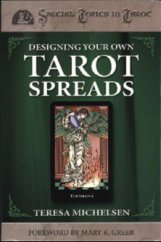
Sheila Hall has been studying the Tarot
for 16 years. She has just received her CTM certification and is
currently working towards her CTI. Sheila is an ATA mentor,
reading on both the Free Tarot and Free Reading Networks, and also
serves on the ATA Education Committee. She lives in Tennessee with
her husband and two sons. |
|
 |
When I first began my Tarot journey, sixteen years ago, there were only a few books available through local bookstores, and no internet. Can you imagine? In the few books that were available, the only spreads that I knew where the good old Celtic Cross and the Horoscope Spread. I made many attempts at working the Celtic Cross, which can seem simple or complex. As a beginner, there was something that I just could not grasp with that spread. So, I focussed on studying each card, in place of attempting readings. After all, it was frustrating enough studying without a mentor. The concept of designing my own spreads honestly never occurred to me. Sometimes, I would ask a question and draw a card, but had trouble relating the answer I received. The question was probably very open-ended or too vague so that understanding it was impossible.
Now, spreads are everywhere, but not all of them fit the question well enough or provide the detailed answers we seek. Designing Your Own Tarot Spreads is a book that can fill the gap. The book teaches you how to design your own spreads, based on the questions or situations you are reading about.
|
The book touches on one card readings. People are surprised at the information that can be derived from simply using one card. The way you phrase the question is very important with one-card readings. The more detailed the question, the clearer the answer can be. Many options are also available when using one card. "You can define upright cards to mean one thing and reversed cards can mean another." Yes/No questions can be answered with one card, and we are also able to consider alternatives.
The question or focus of the reading, how many cards will be used, the layout of the arrangement are just a few of the considerations that need to be addressed when designing a spread. Five or more elements need to be considered, and the book discusses each of the elements in detail.
|
|
As readers, we receive questions that can be vague, very complex, or may have multiple questions that are not always related to one topic area. Designing the spread to fit the question or focus area is the best way to handle these types of readings.
The book discusses defining your own ethics, working with timing, reversals, dignities, and significators. Each chapter ends with practical exercises. The exercises help to give a hands-on type of experience, and also aids the reader in defining their own system and reading style as they go along.
The second section of the book explores inspirations for spread designs, handling multipurpose spreads, love and relationships, and practical spreads. Chapter Twelve covers spreads for making decisions. The pro and cons, factors to consider, and deciding factors can guide people when making decisions about future opportunities and obstacles that may be encountered.
Chapter thirteen guides us through handling Yes/No and predictive type questions that all readers are faced with at one time or another. Readers are very uncomfortable when they receive requests for these types of readings. There is something about making a definite statement about what is going to happen in someone's future. Many readers would prefer to focus on providing a reading that is more empowering to the client so they can see that the "future is not set in stone," and let them know that they "have control over their own lives through the choices they make."
Some readers do predictive types of readings for themselves only, out of curiosity or a need to know about something. I, of course, understand. We all get curious, or have this need to know about something. What I have noticed, when I have attempted a predictive type of reading, is that after I receive the answer, I end up watching and waiting, which can actually be a hindrance to the whole situation and can affect the outcome all together. Can you imagine the clients we read for running around like this? Designing Your Own Tarot Spreads discusses how to work through situations, to each person's satisfaction, when readers are faced with these types of questions.
The last few chapters discuss psychological spreads, interactive readings, spiritual and metaphysical spreads, and even special occasions spreads, like birthdays, and seasonal readings. The book includes spreads, but doesn't offer a bunch of spreads that may or may not relate to a reading that you want to do. You learn how to create your own spreads, too. Diagrams of the layouts are offered, and a glossary of reading terms. There are times when the book reads slightly choppy. This is mostly when transitioning through sections.
I know that if I were just beginning my journey in Tarot, I would be so overwhelmed with the amount of information that is available now. Learning to really read the cards depends on a few factors. To begin with, you need to know the meanings of the cards and how these meanings can change when placed in different spread positions. You also need to know spreads, and how to work with them. With this book, you learn how to create, personalize, and work with spreads for each reading that you do.
Designing Your Own Tarot Spreads, by Teresa Michelsen, is a book in the Llewellyn's Special Topics in Tarot Series. This book is a much-needed addition in the Tarot world. Good reading skills are developed and strengthened when readers know how to work with and read spreads. Beginners can learn how to develop good reading skills, as well as, learn about spreads. Experienced readers can strengthen their spread developing and reading skills.
Designing Your Own Tarot Spreads was written by Teresa Michelsen, and is published by
Llewellyn, ISBN: 0-7387-0263-3.
|


